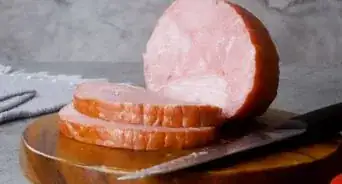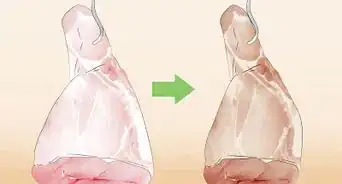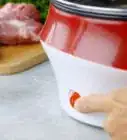This article was co-authored by wikiHow Staff. Our trained team of editors and researchers validate articles for accuracy and comprehensiveness. wikiHow's Content Management Team carefully monitors the work from our editorial staff to ensure that each article is backed by trusted research and meets our high quality standards.
There are 11 references cited in this article, which can be found at the bottom of the page.
The wikiHow Video Team also followed the article's instructions and verified that they work.
This article has been viewed 33,965 times.
Learn more...
Everyone loves a juicy rack of ribs, but a thick membrane on the back of your ribs can make them tough. Removing this “silver skin” before cooking will allow you to season the meat rather than the membrane, and help the ribs stay tender. By locating and loosening the membrane, you can pull it off your ribs for a clean rack that’s ready for your favorite recipe.[1]
Steps
Locating and Loosening the Membrane
-
1Unwrap your ribs. Remove your ribs from their butcher paper and pat them dry with paper towels. Discard the soiled paper towels in the trash.[2]
- Resist the urge to rinse the meat, which can cause cross-contamination in your kitchen and prevent browning.
-
2Turn the rack of ribs so it is curved side down. Place your ribs on a clean surface, such as a cutting board or baking sheet. Orient the ribs so the concave side is facing up and the curved side of the ribs is flat against the board or baking sheet.[3]
- You’ll know the ribs are the right way up when the side with the thick white membrane is facing you.
Advertisement -
3Use a sharp knife to get beneath the membrane. Locate a rib near the middle of the rack by feeling for a firm bone with your fingertips. At the base of that rib on the side closest to you, hold your knife horizontally and push the sharp tip of a paring knife between the rib and the membrane covering it.[4]
- Press the knife between the rib and membrane until the entire blade is covered by membrane.
- Take care not to press the sharp tip of the knife through the membrane.
-
4Lift the membrane with the dull edge of the knife. Turn your paring knife vertically against the rib so the flat, unsharpened edge of the knife lifts the membrane slightly. The sharp edge of the knife will be against the rib bone. A small space of air should open up between the bone and membrane.[5]
- If you’re not confident in your knife skills, slide a dull butter knife into the gap created by your sharp knife to loosen the membrane. This lessens the chances you accidentally cut through the silver skin.
-
5Tilt the knife up at a 30-degree angle. Press the sharp side of your knife against the rib bone and lift upward with the handle of the knife. Keep the sharp side of the knife in contact with the rib. This hinge motion will help lift the membrane further.[6]
- Remove your knife from the ribs and set it aside.
Pulling the Membrane off Your Ribs
-
1Work your finger into the gap between the bone and membrane. Press your index finger into the space the knife has opened up under the membrane. Wiggle your finger from side to side to separate the membrane further and enlarge the gap.[7]
- Try to lift enough of the membrane with your finger so that there is a grip-able flap of membrane tissue.
-
2Use a paper towel to grip the membrane. Place a clean paper towel on top of your dominant palm so it covers your index finger and thumb. Grasp the paper towel in your hand, and use it to grip the loose edge of the membrane between your thumb and index finger.[8]
- The paper towel will give you extra traction while holding the strong and slippery membrane.
-
3Work your fingers beneath the membrane to the other side of the ribs. Hold the ribs steady with your non-dominant hand, and pull up on the membrane flap using the paper towel in your dominant hand. As you lift, press the fingers of your non-dominant hand through to the other side of the rib.[9]
- Your fingers will emerge on the other side, creating a small loop of membrane.
- If the membrane starts to tear as you lift up, use your knife to separate the rib and membrane on the opposite side of the ribs to meet the side you’ve been working on.[10]
-
4Pull the membrane up and away from the ribs. Slip two fingers of your dominant hand into the membrane “handle” that’s been formed by the space between the rib and the membrane. Press down on the ribs with your other hand, and pull the membrane straight up and off the ribs. It should come off in one piece.[11]
- If your rack of ribs is very long, readjust your grip on the membrane as needed, moving closer to the edge to lift the membrane all the way off.
- If your grip slips as you pull up on the membrane, grab a paper towel and grip through that for more traction.
-
5Discard the membrane. Throw the thick, silvery membrane that comes away from the ribs into the trash. Your ribs are now clean and ready to be seasoned and cooked to suit your taste.
Community Q&A
-
QuestionWhat if I forget to remove the membrane?
 Galasy4969Top AnswererThe meat will cook unevenly; however, it will still be perfectly edible. You may need to use a cartilage knife to cut it off.
Galasy4969Top AnswererThe meat will cook unevenly; however, it will still be perfectly edible. You may need to use a cartilage knife to cut it off.
Things You’ll Need
- Paring knife
- Paper towels
- Ribs
- Cutting board or baking sheet
References
- ↑ https://www.thekitchn.com/5-mistakes-to-avoid-when-cooking-ribs-232238
- ↑ https://www.chowhound.com/food-news/113229/should-you-rinse-meat-before-cooking-it/
- ↑ https://www.youtube.com/watch?v=fv32zg507EM&feature=youtu.be&t=109
- ↑ https://www.youtube.com/watch?v=fv32zg507EM&feature=youtu.be&t=114
- ↑ http://www.finecooking.com/article/how-to-remove-silverskin-from-ribs
- ↑ https://www.youtube.com/watch?v=fv32zg507EM&feature=youtu.be&t=140
- ↑ https://www.youtube.com/watch?v=fv32zg507EM&feature=youtu.be&t=144
- ↑ https://www.bbqjunkie.com/bbq-recipe/cleaning-spareribs/
- ↑ https://www.youtube.com/watch?v=fv32zg507EM&feature=youtu.be&t=166
About This Article
To remove membrane from ribs, place the ribs curved side down on a cutting board. Toward the center of the rack, slide a sharp knife between the membrane and the bone, and flip knife vertically and turn it 30 degrees to use the dull edge to separate the membrane. Carefully slide your finger between the membrane and bone, using a paper towel to help you grip the membrane tighter. Begin peeling the membrane away, using one hand to pull and the other to hold the ribs in place. Once the membrane is removed, discard it and begin preparing the ribs. To learn more, like how to easily get the membrane off in one piece, keep reading!




















































